High in the far north of Vietnam lies a place where the road isn’t just a path, but an experience. The Ha Giang Loop is an absolute dream come true for adventurous travelers craving the open road and breathtaking scenery. This four-day motorbike journey winds through jaw-dropping canyons, navigates challenging mountain passes, and introduces you to the vibrant cultures nestled within Vietnam’s most spectacular landscapes. Pack your gear, charge your batteries, and prepare for an unforgettable adventure on the Ha Giang Loop.
Discovering the Ha Giang Loop: A Geographic and Cultural Marvel
The Ha Giang Loop follows a rough circuit, primarily utilizing the QL4C and QL34 highways, traversing some of Vietnam’s most remote and rugged terrain. This region is part of the Dong Van Karst Plateau Geopark, recognized by UNESCO for its unique geological formations sculpted over millions of years.
Limestone karsts rise dramatically from lush valleys, creating a landscape unlike anywhere else. Beyond the stunning geology, the loop is a gateway to understanding the diverse ethnic tapestry of Vietnam, home to communities like the H’mong, Dao, Tay, and Nung people, whose distinct traditions and ways of life are woven into the fabric of the mountains. This journey is not just about the ride; it’s a deep dive into nature and culture.
Riding the Ha Giang Loop: A Day-by-Day Exploration
This typical four-day itinerary offers a comprehensive immersion into the beauty and challenges of the Ha Giang Loop, providing stunning vistas and cultural encounters at every turn. Each day presents new landscapes and experiences, pushing your limits and rewarding you with unparalleled views.
Day 1: Ha Giang City to Yen Minh – The Journey Begins
The adventure kicks off from Ha Giang City. An early start is key. As you head north on the QL4C, the transition from relatively flat terrain to a dramatic limestone mountain range is swift and awe-inspiring. This marks your entry into the Dong Van Karst Plateau. The lush jungle clinging to the slopes adds to the raw beauty.
The highlight of this initial stretch is navigating the Heaven’s Gate Pass. Here, you get your first true taste of the exhilarating views the Ha Giang Loop is famous for, combined with the challenge of tight, winding curves. It’s a perfect introduction to the riding ahead. Descending from the pass, you arrive in Tam Son, often called “Heaven’s Gate,” a charming town cradled by those signature jutting, forested hills. This is an ideal spot to pause, refuel with lunch, and enjoy the classic Northern Vietnamese fare available at local restaurants and roadside stalls. And yes, finding a great Vietnamese coffee here is never a problem.
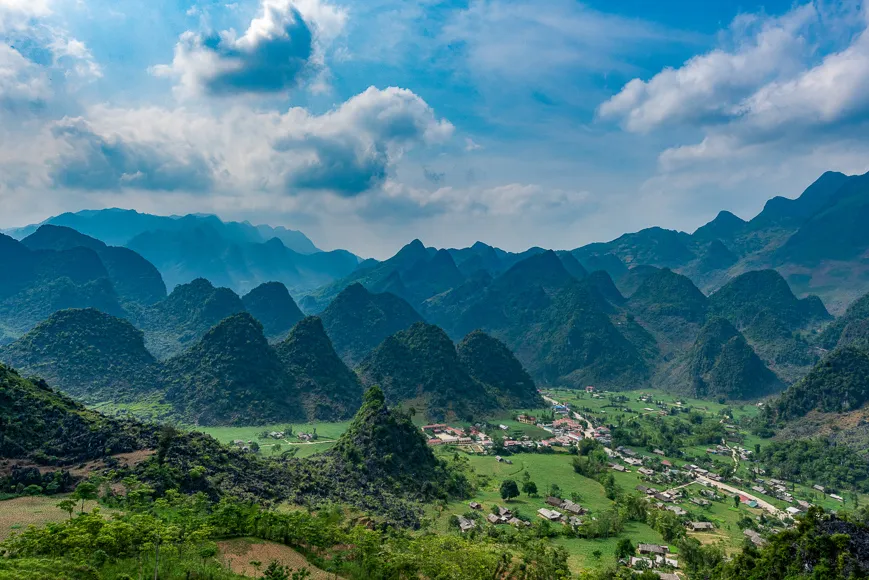 Dong Van Karst Plateau Geopark
Dong Van Karst Plateau Geopark
Discover the Best of What to Do in Downtown Denver – Your Ultimate Guide
Discover the Best Brunch in Denver – A Local’s Guide
Top 10 Places to Visit in Nevada with Family for an Epic Trip
The afternoon ride continues on the QL4C towards Yen Minh. The road here often follows the scenic Mien River, offering a gentler ride before climbing once more through tall canyons. You’ll cruise through more karst plateaus and mountain passes, each turn revealing new perspectives of this dramatic landscape. Arriving in Yen Minh signals the end of the first day’s ride. Settling into a local hotel or homestay provides a comfortable rest before the next leg of the journey.
TIP: Planning your accommodation ahead of time, especially during peak season, is highly recommended. The best hotels and homestays in these smaller towns can fill up quickly, ensuring you have a comfortable place to rest after a day of riding the Ha Giang Loop.
Day 2: Pushing North Towards the Vietnamese Border
Start your day with a hearty breakfast, perhaps a steaming bowl of pho, a staple that provides the perfect fuel for the road ahead. Setting off from Yen Minh on the QL4C northeast towards Dong Van, the road quickly begins to climb steeply. As you gain elevation, you often rise above the tree line, revealing an otherworldly landscape of eroded limestone karsts. The views are simply incredible, constantly changing with every turn of the road.
A notable section on this day is Dốc Chín Khoanh, or Nine Turn Pass. This is more than just a road; it’s a photogenic masterpiece. Stopping here allows you to admire the series of switchbacks descending into the valley below, a testament to the engineering required to build roads in this challenging terrain. The Sà Phìn area is a convenient stop for a quick break, food, and ensuring your motorbike is topped up with fuel.
 Dong Van City Ha Giang Loop
Dong Van City Ha Giang Loop
The afternoon offers an optional, but highly rewarding, detour to the Lung Cu Flag Tower. Located near the border with China, reaching the tower requires a three-hour round trip detour. The effort is well worth it for the panoramic 360-degree views extending over the borderlands. Back on the QL4C, the remaining ride to Dong Van town is filled with more stunning vistas. Dong Van is your stop for the night. Make sure to allocate time to visit the local market. Whether you explore it in the evening or the early morning, it’s a vibrant cultural hub where you can witness the colorful ethnic minorities trading goods and socializing.
 Colourful local markerts
Colourful local markerts
TIP: Local markets on the Ha Giang Loop often follow specific schedules, sometimes meeting only on certain days of the lunar calendar. Checking with your host in Dong Van about the market days and times is highly recommended for this unique cultural experience.
Day 3: Conquering the Majestic Mã Pí Lèng Pass
This day is often considered the absolute highlight for many riding the Ha Giang Loop. Departing from Dong Van, the road leads you directly towards what is arguably the most mind-blowing stretch of road in all of Vietnam: the section leading up to and over Mã Pí Lèng Pass. The valley floor drops away dramatically hundreds of meters below as the road snakes along the sides of massive peaks and through deep canyons carved by time and the elements. The sheer scale of the landscape is breathtaking.
The biggest challenge on this stretch isn’t the road condition, but resisting the urge to stop every few hundred meters. Every single turn presents a picture-perfect view that demands your attention. From the towering rock faces to the distant ribbon of the Nho Que River below, the scenery is simply spectacular.
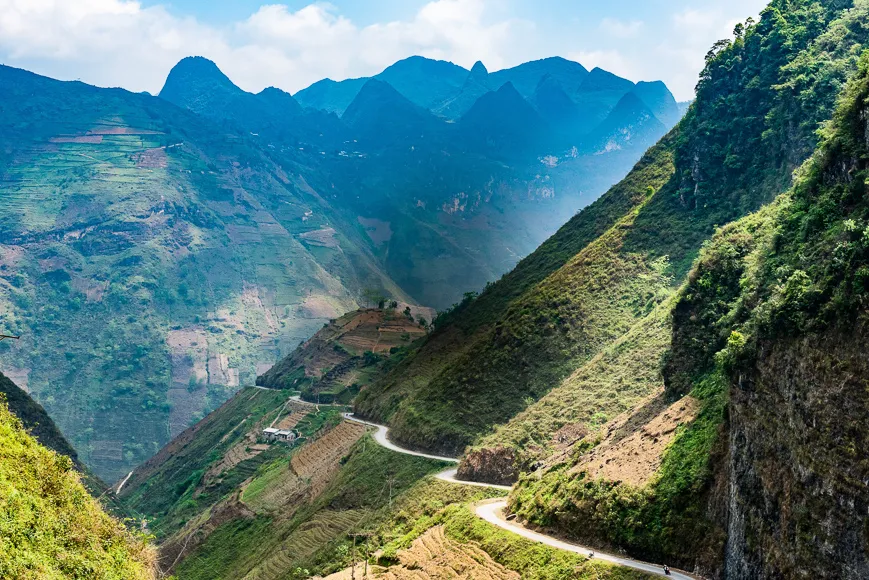 Ma Pi Leng pass
Ma Pi Leng pass
While Mèo Vạc is only about 24 kilometers from Đồng Văn, the ride will likely take a significant portion of your morning due to the countless stops you’ll want to make to fully appreciate the panoramic views along the way to Mã Pí Lèng. Once you reach Mèo Vạc, take time to enjoy this quaint town. It has a colorful character, particularly vibrant on market days, and offers several options for a well-deserved lunch.
The afternoon allows for a quick but exciting detour. At the bottom of Mã Pí Lèng Pass, taking a left off the QL4C onto side road 193A offers a closer look at the winding Nho Quế River. It’s a short ride down to the river level, providing a different perspective of the canyon you just rode through.
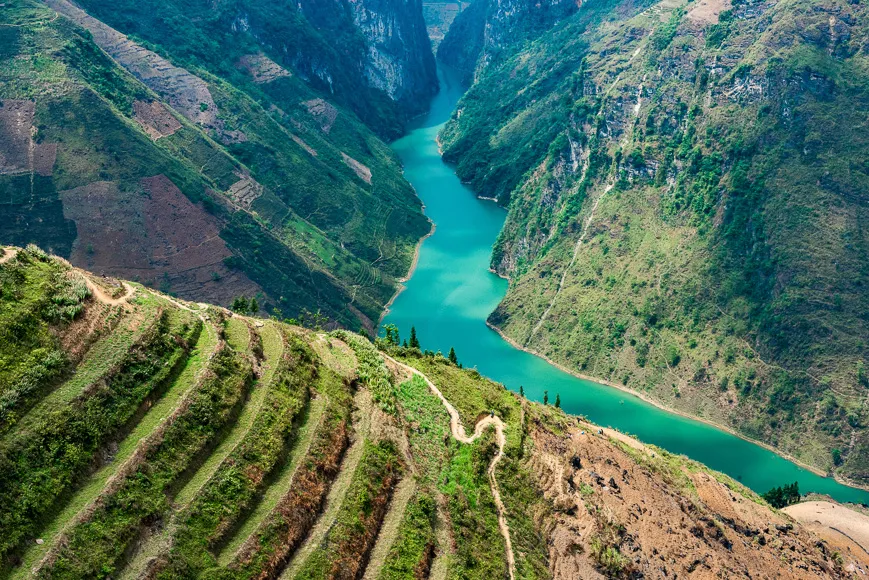 Ha Giang Loop Guide
Ha Giang Loop Guide
You’ll finish your third day on the Ha Giang Loop in Bảo Lâm. This small hamlet is known for its wonderfully warm and hospitable locals. Spending a few hours relaxing in this remote, peaceful setting is the perfect way to unwind and ready yourself for the final leg of the journey back to Hà Giang City the following morning.
Day 4: The Return Journey to Hà Giang City
The final day of your Ha Giang Loop adventure begins with a simple breakfast in Bảo Lâm. It’s wise to stock up on any provisions you might need for the journey back to Ha Giang City, as stops may be less frequent on this route. From Bảo Lâm, you’ll take the QL34 southwest. This road offers a different character compared to the dramatic QL4C.
The QL34 largely follows the Gâm River along the valley floor for much of the way. This makes for an enjoyable and slightly less demanding drive after the intensity of Mã Pí Lèng. While there will still be plenty of twists and a few passes to navigate, they are generally not as steep or challenging as the previous days.
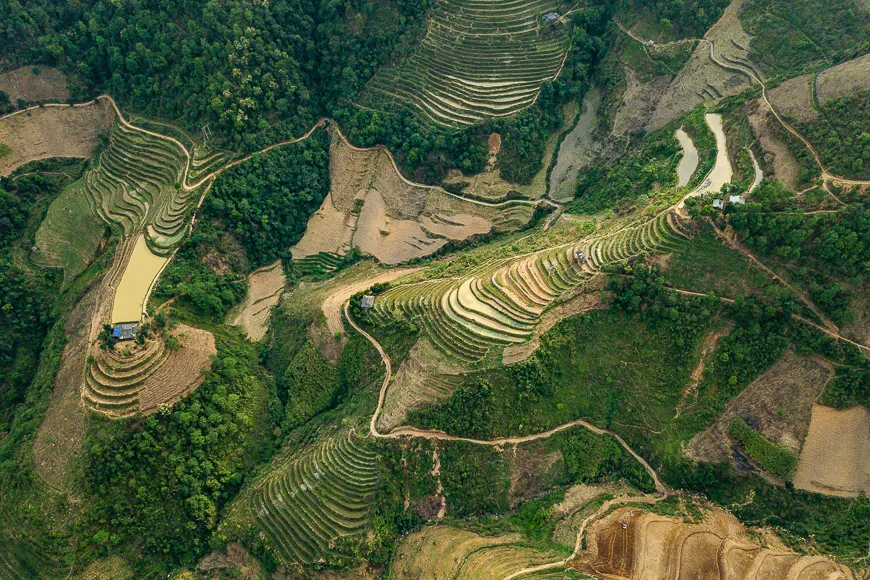 Ha Giang Loop Travel
Ha Giang Loop Travel
Stopping in Bắc Mê offers a good opportunity for a bite to eat at one of the local food stalls. As you continue towards Ha Giang City, you’ll find fewer towns and settlements in this final stretch. Enjoy the last moments of riding through the scenic Northern Vietnamese countryside.
Arriving back in Hà Giang City marks the completion of the Ha Giang Loop. After covering many miles and experiencing the rugged beauty and warm hospitality of the region, you’ve earned some modern comforts. Reflect on the incredible landscapes, the challenging roads, and the cultural insights gained over the past four days.
Beyond the Ride: Culture, Cuisine, and Encounters on the Ha Giang Loop
The Ha Giang Loop is far more than just a scenic drive; it’s a profound cultural immersion. The region is home to numerous ethnic minority groups, each with their distinct languages, traditional clothing, customs, and agricultural practices. Encounters with the H’mong, Dao, Tay, and Nung people, often seen working in the terraced fields or trading at the lively local markets, provide a glimpse into ways of life that have endured for centuries amidst the challenging mountain environment. The markets, in particular, are vibrant social and commercial hubs, bursting with color, sounds, and the unique aromas of local produce and prepared foods.
Cuisine on the Ha Giang Loop is simple, hearty, and deeply connected to the local environment. Expect fresh, seasonal ingredients grown in the mountainous terrain. While Pho is readily available, adventurous eaters should seek out local specialties. Thang Co, a traditional stew made from the organs of horses, buffalo, cows, or pigs, is a staple among the H’mong people, often enjoyed communally at markets.
Steamed corn cake (Banh Dac Y) is another local delight, reflecting the importance of corn in the mountainous diet. Trying the local corn wine (Ruou Ngo) is also a unique cultural experience, though best done responsibly after the day’s ride. These dishes aren’t just food; they tell a story of adaptation, resourcefulness, and community in a remote land.
Essential Tips for Conquering the Ha Giang Loop
Successfully navigating the Ha Giang Loop requires preparation and awareness. Here are some key tips to ensure a safe and enjoyable journey:
- Cash is King: You will be traveling through remote areas with limited banking facilities. Ensure you carry enough cash for accommodation, food, fuel, and any unforeseen expenses. ATMs are scarce outside of Ha Giang City.
- Getting There: Most travelers reach Ha Giang City from Hanoi. Overnight sleeper buses are a popular and efficient option, departing regularly from Hanoi’s My Dinh bus station. Private transfers and organized tours are also available for different budgets and preferences.
- Motorbike Selection: Motorbikes for rent are widely available in Ha Giang City. Options range from semi-automatic scooters to manual clutch bikes (like Honda Winner or various dirt bikes). Choose a bike you are comfortable and experienced riding, especially given the varied terrain and sometimes challenging conditions. Ensure the bike is well-maintained before you set off. Honda and Kawasaki service centers are available in Ha Giang town for major issues.
- Road Conditions and Safety: While major sections of the Ha Giang Loop are paved and in good condition, you must be prepared for sudden changes. Obstacles like livestock, landslides, construction, or potholes can appear unexpectedly. Always approach blind corners and curves with caution. Drive defensively and be aware of local traffic patterns. It is crucial to drive only during daylight hours. The roads are not lit, and visibility can be poor after dark due to fog or rain.
- Weather: The weather in the mountains can change rapidly. Be prepared for sunshine, rain, fog, and varying temperatures, even within the same day. Pack layers.
- Accommodation: While booking ahead is wise during peak season, you can often find homestays or guesthouses (Nha Nghi) in the towns along the route (Yen Minh, Dong Van, Meo Vac, Bao Lam).
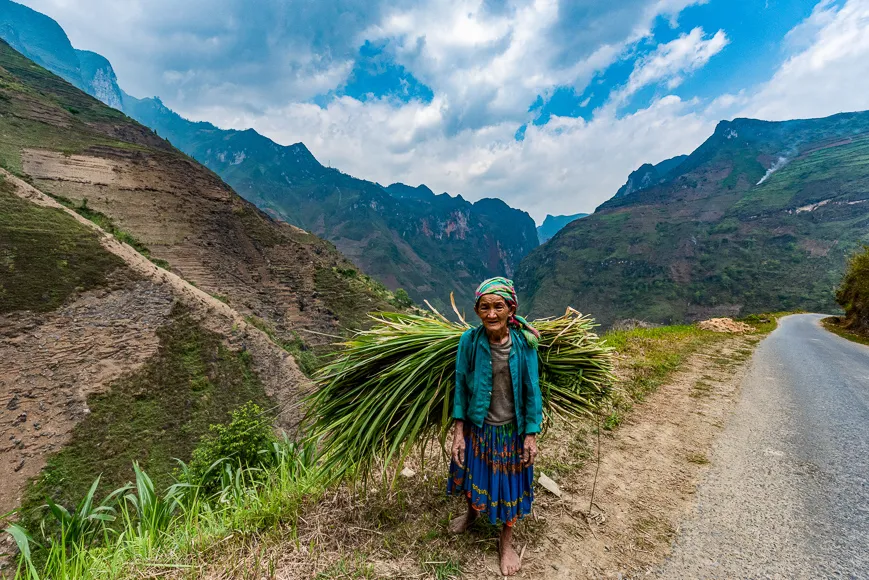 Ha Giang Loop
Ha Giang Loop
Frequently Asked Questions about the Ha Giang Loop
Q: How many days does the Ha Giang Loop typically take?
A: The most common itinerary for the Ha Giang Loop is 3 to 4 days. A 4-day trip allows for a more relaxed pace, including detours and more time to soak in the culture and scenery.
Q: Is the Ha Giang Loop dangerous?
A: The Ha Giang Loop can be challenging and carries inherent risks due to winding mountain roads, variable conditions, and local traffic. However, for experienced riders who prioritize safety, drive cautiously, and are prepared for unexpected obstacles, it is manageable. Driving within your limits and avoiding night riding are key.
Q: What is the best time of year to do the Ha Giang Loop?
A: The best times to visit the Ha Giang Loop are generally from September to November (autumn, dry and pleasant) and from March to May (spring, flowers blooming). The harvest season (late September/October) offers views of golden rice terraces. December to February can be very cold with potential for fog or even frost. June to August is the rainy season, which can make roads slick and increase landslide risk.
Q: Can I do the Ha Giang Loop if I’m not an experienced motorbike rider?
A: Riding the Ha Giang Loop involves navigating steep inclines, sharp turns, and varying road surfaces. While some less experienced riders attempt it on semi-automatic scooters, it is strongly recommended that you are comfortable and competent riding a motorbike before undertaking this trip. Alternatively, you can hire an experienced local guide (often called an “easy rider”) to drive you on the back of their bike, allowing you to fully enjoy the scenery without the stress of navigating the roads.
Q: What kind of motorbike is best for the Ha Giang Loop?
A: For the challenging mountain roads, a manual clutch bike (like a 125cc or 150cc Honda Winner, XR, or similar) is generally preferred by experienced riders for better control, especially on descents. However, many people successfully complete the loop on semi-automatic scooters if they are cautious and the bike is in good condition.
Completing the Ha Giang Loop is an achievement and an experience that stays with you long after the ride is over. It’s a true adventure into the heart of Northern Vietnam’s natural and cultural wonders. If you’re looking for a journey that challenges, inspires, and connects you deeply with a remarkable part of the world, the Ha Giang Loop awaits.
